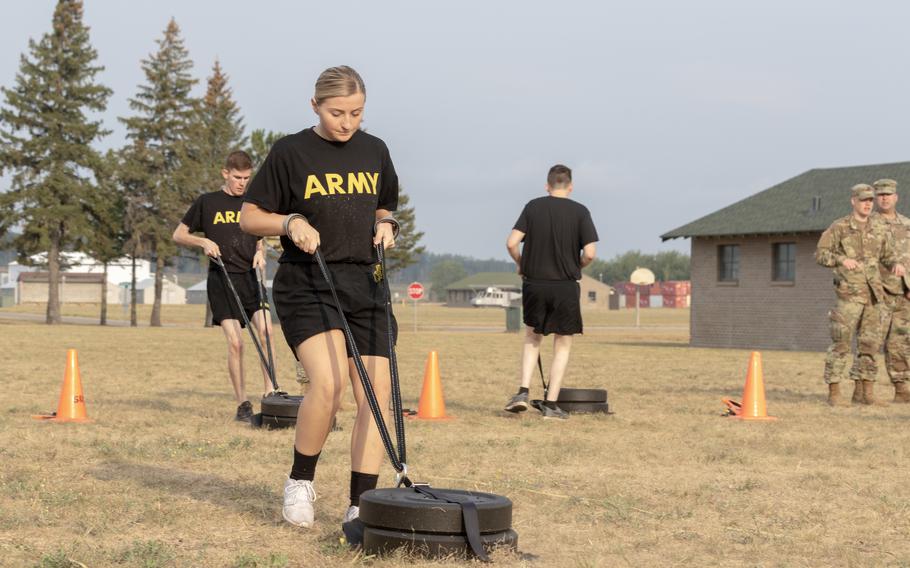Soldiers take the Army Combat Fitness Test at Fort McCoy, Wis., in July 2022. (Amanda Clark/U.S. Army)
The Army could be forced to reimplement gender-neutral standards for at least some of its soldiers for its combat fitness test or scrap the current CrossFit-style physical assessment altogether under competing amendments in defense bills pending in the House and Senate.
The House and Senate Armed Services committees last week approved separate versions of the fiscal 2024 National Defense Authorization Act, sending bills to the full chambers with different plans on how to manage the Army’s long-running implementation of its fitness test. In October, after years of studies and delays, the Army officially implemented its six-event Army Combat Fitness Test, or ACFT, which was meant to simulate the physical demands of combat.
Service leaders have long touted the new fitness test as a dramatic improvement over the decades-old Army Physical Fitness Test, but some lawmakers have spent years pushing back on the assessment over a variety of issues including its standards for men and women and the amount of equipment needed to train for and take the test.
The House Armed Services Committee’s draft of the 2024 NDAA — the annual must-pass law that sets Congress’ policy and spending priorities for the Pentagon — would impart “sex-neutral fitness standards” for soldiers in front-line combat specialties. Meanwhile, the Senate Armed Services Committee’s version of the bill would kill off the Army Combat Fitness Test, and slowly return the service to the 1980’s-era Army Physical Fitness Test, or APFT, which includes pushups, situps and a two-mile run.
The House bill was approved June 22 and the Senate bill was approved the following day. The bills remain far from becoming law. They must be passed by the full chambers and differences between the two measures must then be reconciled before they can be sent to President Joe Biden’s desk for his signature into law.

Soldiers participate in the sprint-drag-carry event of the Army Combat Fitness Test in August 2021 at Camp Ripley, Minn. (Mahsima Alkamooneh/Minnesota National Guard)
An Army spokesperson declined comment Wednesday on either version of the bill, citing the ongoing legislative process. A service official, however, wrote in an email that a return to the APFT would be undesirable and “a giant leap backward” for soldiers’ fitness. The official commented on condition of anonymity.
The Senate’s version would reimplement the APFT over three years, according to an executive summary of the bill released by the Armed Services Committee last week. That would include a two-year pilot program of the old fitness test followed by a yearlong waiting period before it can be reimplemented as the standard Army fitness test. It would also require service leaders to brief Congress on the test.
The House’s approach would keep the ACFT in place, but it would impose one standard passing grade for men and women serving in close combat jobs, including in special forces, infantry, armor, cavalry, artillery and combat engineer specialties.
Army leaders recently had been working separately from Congress to reimplement gender-neutral standards for the most physically demanding career fields, according to the Army official. Initial versions of the test rolled out in 2019 eyed gender- and age-neutral standards, and the service initially proposed grading soldiers on a scale based on the physicality of their job.
But those plans were scrapped as lawmakers and some soldiers raised concerns over some female soldiers’ ability to pass the test, which is vital to progressing in a service member’s career. Studies showed less than 50% of female soldiers were passing early versions of the ACFT. When the Army finally implemented the ACFT in October, it included separate grading scales for men and women.
Gen. James McConville, the Army chief of staff, told Congress last year that injury rates among soldiers had somewhat improved since they began training for and taking the ACFT ahead of its official implementation.
The Army began developing the ACFT in 2010 as an attempt to improve fitness and resiliency among its troops nearly a decade into the wars in Afghanistan and Iraq. Service officials at that time argued the decades old APFT placed too much weight on a soldier’s running ability and did not adequately gauge a service member’s ability to perform critical functions in combat, such as heaving heavy equipment or dragging a wounded trooper to safety.
After several studies, the final version implemented last year included six events — a dead lift, hand-release pushups, a plank, a medicine ball throw, a sprint-drag-carry event, and a two-mile run.